Pneumatic post
Pneumatic post in metropolises.
Probably the term "pneumatic post" does not ring a bell to you, because this form of mail has never been used in the Netherlands. In many large cities in Western Europe such as London, Paris, Vienna, Rome, Berlin and Prague, this particular method of mail has been used in practice.
Post through a tube
 The basic idea of pneumatic post is simple. Put the mail in a cartridge, and send this cartridge by pressure through a tube to its destination. The basic driving force is air pressure or pneumatics. The principle of air pressure goes back to the year 100 BC, Heron of Alexandria. Think of a hot summer day, on a terrace with a nice cold drink and a straw... By sucking on the straw, you create vacuum in the straw. The liquid in the glass will be sucked up into your mouth due to this sub-atmospheric pressure. Blow gently into the straw, and the fluid level in the straw lowers again and the liquid flows back into the glass. This is the working principle of pneumatic or air pressure. The basic idea of pneumatic post is simple. Put the mail in a cartridge, and send this cartridge by pressure through a tube to its destination. The basic driving force is air pressure or pneumatics. The principle of air pressure goes back to the year 100 BC, Heron of Alexandria. Think of a hot summer day, on a terrace with a nice cold drink and a straw... By sucking on the straw, you create vacuum in the straw. The liquid in the glass will be sucked up into your mouth due to this sub-atmospheric pressure. Blow gently into the straw, and the fluid level in the straw lowers again and the liquid flows back into the glass. This is the working principle of pneumatic or air pressure.
Around 1800 the Scottish engineer William Murdoch used this principle for his invention: pneumatic post. A tubular cartridge fits, by means of a flexible seal, just in a transport tube. When we connect the end of the transport tube to a fan and let it blow into the tube the pressure rises. Due to this pressure the cartridge will start to move from the fan:
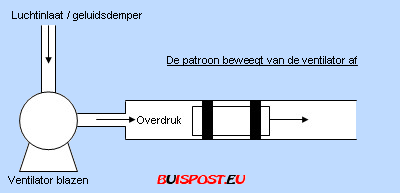
On the other hand, if we let the fan suck on the transport tube, the cartridge will start to move in the opposite direction towards the fan:
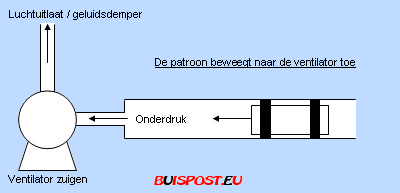
In this way the cartridge moves through the transport tube. In the base station (pneumatic post office) a switch is mounted on each transport tube, which detects cartridges and tells the pneumatic controller to turn off the fan (see the maximum card below).

Industrial Revolution
The Pneumatic Despatch Company was founded in London in 1859 after several successful experiments with sending mail through a specially constructed network of tubes. These tubes measured three meters in diameter and wagons with bags of mail were sent to Euston Station Eversholt Street and vice versa.
The invention of the steam engine and its applications in all types of transport machinery did cause an "industrial revolution". The world began to change and cities grew due to the prosperity and changing economic conditions. Streets became crowded and pneumatic post was seen as the solution to enable swift delivery of the mail. In most cities the Stock Exchange was the main station in the tube network. Apparently they had most advantage of fast mail delivery.
Historical development of postal tubes in various cities:
- 1853: the London Stock Exchange was linked with the city's main telegraph station (a distance of 220 yards)
- 1865: in Berlin (until 1976), the Rohrpost, a system of 400 kilometers total length at its peak in 1940Historische ontwikkeling van buizenpost in diverse steden:
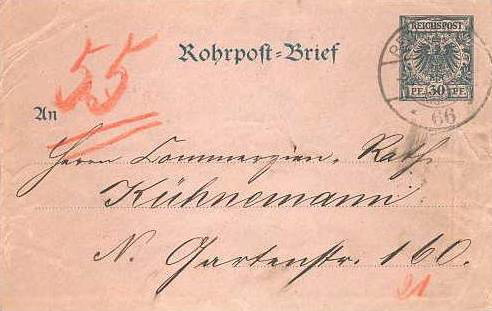
Tube post (Rohrpost) Germany
- 1866: Paris (until 1984, total length of 467 kilometers in 1934)
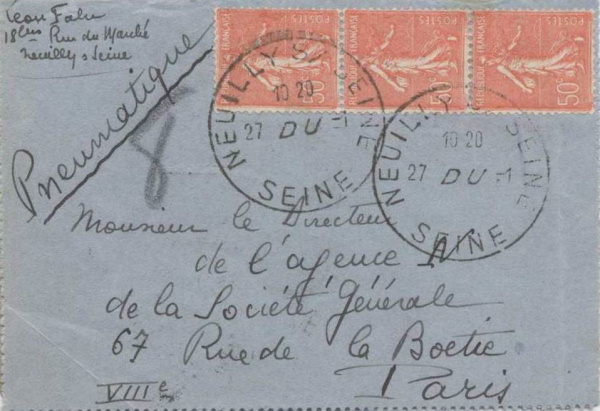
Indiacation "Pneumatique" on French letter
- 1875: in Vienna (until 1956)
- 1887: in Prague (until 2002 due to flooding), the Prague pneumatic post
- 1897: New York City (until 1953)
- Other cities include: Munich, Rio de Janeiro, Buenos Aires, Hamburg, Rome, Naples, Milan, Marseille, Melbourne, Boston, Philadelphia, Chicago, St. Louis.
High speeds
Underground fairly high speeds could be achieved. In Paris the compressed air powered cartridges travelled as fast as seventy kilometers per hour. In 1966 France issued a special stamp to mark the centenary of the pneumatic post service. The Stock Exchange building, depicted in the centre of the network, was even accessible by tube until 1984.
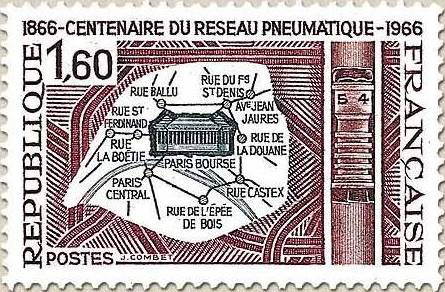

In Italy different stamps specifically for tube mail have been issued between 1913 and 1945:
Postal stationary from a few other countries

Special card for Vienna pneumatic post

Italian pneumatic post stamp on letter
What has pneumatic post to do with motorcycles?
In an urban area pneumatic post is the best way to send mail quickly from office to office. From the pneumatic post offices the mail was brought to the final recipients by mail men. In the center of cities where tube post has been implemented mail will be sent to addresses within that region, but also to urban areas on the outskirts of the city or even outside the city. In that case, only part of the journey was made by pneumatic post. From the pneumatic post office, the mail was further delivered by the normal postal transport.
In Paris mail heading for certain suburbs, banlieues, outside the pneumatic post region was further transported by motorcycle.
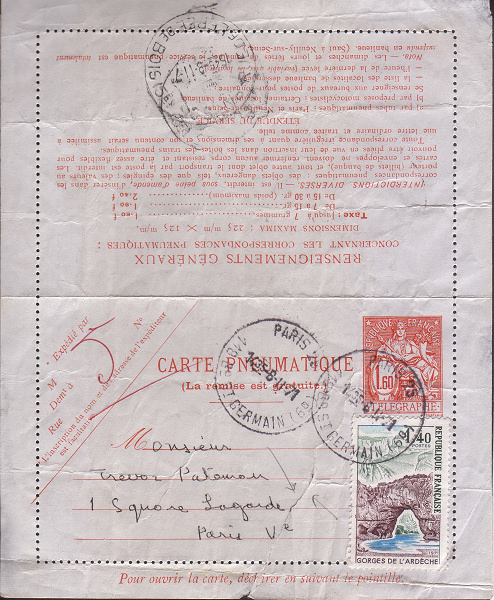

See choice b) on the form
This special form of transport is only indicated on the Carte Pneumatique type 'Chaplain'. This pneumatic card comes in four different values: 1 Fr 60, Fr 3, 8 and 12 Fr 40 Fr.
More information about postal tubes can be found on the website: buispost.eu.
Nico Helling
Top - Back to former page - Home |
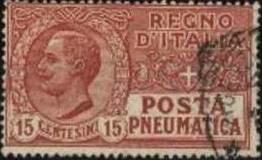





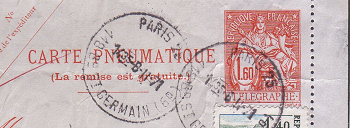


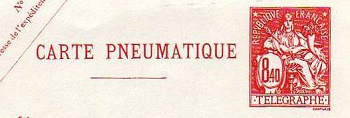
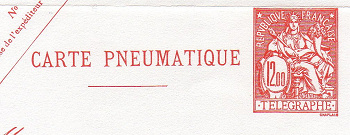
 The basic idea of pneumatic post is simple. Put the mail in a cartridge, and send this cartridge by pressure through a tube to its destination. The basic driving force is air pressure or pneumatics. The principle of air pressure goes back to the year 100 BC, Heron of Alexandria. Think of a hot summer day, on a terrace with a nice cold drink and a straw... By sucking on the straw, you create vacuum in the straw. The liquid in the glass will be sucked up into your mouth due to this sub-atmospheric pressure. Blow gently into the straw, and the fluid level in the straw lowers again and the liquid flows back into the glass. This is the working principle of pneumatic or air pressure.
The basic idea of pneumatic post is simple. Put the mail in a cartridge, and send this cartridge by pressure through a tube to its destination. The basic driving force is air pressure or pneumatics. The principle of air pressure goes back to the year 100 BC, Heron of Alexandria. Think of a hot summer day, on a terrace with a nice cold drink and a straw... By sucking on the straw, you create vacuum in the straw. The liquid in the glass will be sucked up into your mouth due to this sub-atmospheric pressure. Blow gently into the straw, and the fluid level in the straw lowers again and the liquid flows back into the glass. This is the working principle of pneumatic or air pressure.





